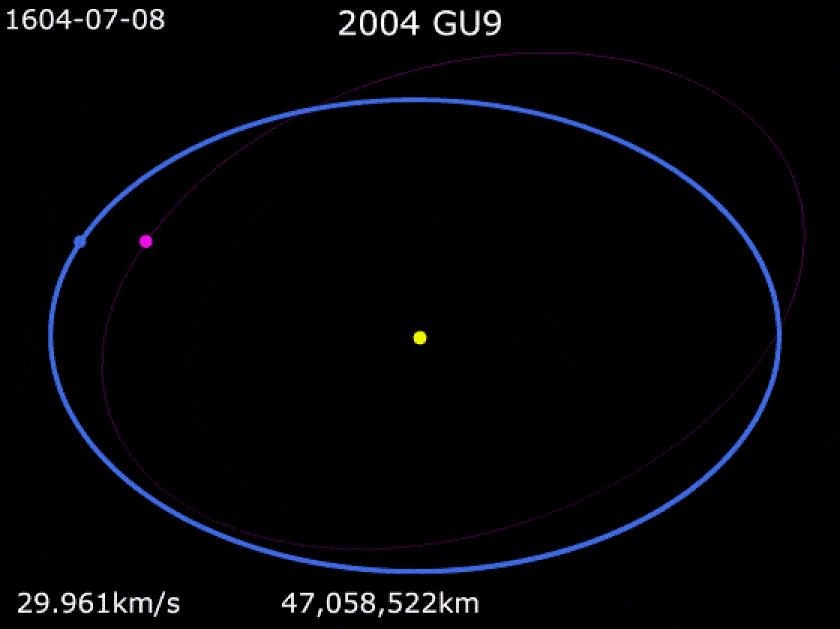New contest lets you name Earth's 1st 'quasi-moon' for free. Here's how to enter.

Have you ever wanted to name a part of the solar system? Well now's your chance: A new contest will let a lucky participant name one of Earth's "quasi-moons."
Anybody can submit a potential name for our planet's tiny, temporary satellite for free — and we can show you how.
Quasi-moons, also known as quasi-satellites, are objects that orbit the sun closely alongside a planet. A quasi-moon may initially appear to be orbiting its planetary companion. However, in reality, they merely have a similar trajectory and orbital speed around the sun, which means they are constantly near the planet but not orbiting it. This association is only temporary because quasi-moons are never captured by their partner's gravity and eventually fall out of sync with them.
Earth has seven known quasi-moons, which are all asteroids, according to The Planetary Society. Several of these temporary satellites have been uncovered in the last few years, such as 2023 FW13 — the most recently discovered quasi-moon, which was first spotted in March last year. And so far, only one of Earth's quasi-moons, Kamo'oalewa, has been officially named.
Quasi-moons should not be confused with minimoons, which are small bodies that do orbit Earth, but only for short periods — less than a year on average — before escaping our planet's gravitational pull.
Astronomers are interested in both quasi-moons and minimoons because these space rocks are some of the most easily accessible asteroids from Earth, making them prime targets for missions to collect asteroid samples. Some scientists also believe that these temporary satellites could be used as stepping stones for interplanetary travel.
Related: Undiscovered extra moons may orbit Earth. Could they help us become an interplanetary species?

In the "Name a Quasi Moon!" contest, which is being run jointly by the Radiolab podcast and the International Astronomical Union (IAU), members of the public can submit potential names for 2004 GU9, also known as asteroid 164207, which became Earth's first known quasi-moon when it was discovered 20 years ago. This space rock is less than 3,300 feet (1,000 meters) wide and will likely travel alongside Earth until 2600, according to a 2010 study.
The idea to finally name this quasi-moon was first put forward by Radiolab after the podcast helped to successfully name Venus' only known quasi-moon, Zoozve, in February after co-host Latif Nasser spotted a typo of the asteroid's name in a solar system map.
"I had so much fun helping to name Venus's quasi-moon [Zoozve] that I wanted the whole world to get that same chance," Nasser said in an IAU statement. "I can't wait to hear the names people come up with for our weirdo rockstar neighbour."
How to enter
Anyone over 18 years old can enter the new contest from anywhere around the globe by submitting a name in an online form. However, there are a few rules and additional considerations to take into account before you enter.
First, suggested names must have a mythological origin, meaning they must be from a character or object in any mythology. Second, names must be a maximum of 16 characters long and written using the Latin alphabet — the same 26 letters used in English (A-Z).
You also cannot use names already given to space objects, or include any words with political or military affiliations. Anything related to creation myths, the Trojan War described in Homer's "Iliad" or Amazonian warriors from Greek poems is also off-limits, according to Radiolab, as such names are reserved for outer solar system objects.
related stories
—10 out-of-this-world solar system discoveries made in 2023
—15 incredible images of Earth's moon
—Where does the solar system end?
To submit a name, you must write a short citation (maximum 360 words) explaining what the name means. This will be included in the IAU's official naming announcement when the competition has concluded.
You can also write a longer statement (maximum 1,500 words) to describe why you have picked the name and why it should win.
Submissions opened on June 1 and can be made until Sept. 30. Judges will select their 10 favorite potential names, which will then be put to a public vote in November. The winning name is expected to be announced in January 2025.

